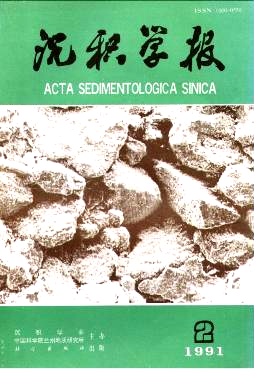Volcanic Rock and Radiolarian Silicilith of Wufeng Formation in Lower Yangtze Region
- Received Date: 1991-01-19
- Publish Date: 1991-06-10
Abstract: Shallow sea deposit or deep sea deppsit? two different opinions about its origin had been put forward since Wufeng Formation was named in 1931. Researching the cross-section of Wufeng Formation again in Lunshan mountain of Jurong county, Jiangsu Province, in 1989, the authors found profuse Fadiolarians in silicilith and volcanic rock intercalated between silicilith layers, which provides evidences for volcanicism, oringin of the silicilith, and tectonic evolution during Wufeng Age. Thicker than 6.33m which divided into 26 layers, containing abundant radiolarians and graptolithines and spongioid spicules but not benthons, the formation of Upper Ordovician Series is mainly composed of dark thinlayered chertlith and siliceous shale, intercalated more than 97 layers (0.1 to 7cm thick per layer) of yellow mudded volcanic rock as well as a little lava. With the primary composition ranging from neutrality to neutral-basicity to alkaline-neutrality, the volcanic rock consists principally of neutral crystal-vitrie tuff and volcanic dust tuff with a little ignimbrite and andesitic lava and autoclastic- lavaflow- pyroclastic, all of which had illitized, vermiculitized and chloritized.The frequency of volcanic eruption was 8 to 18 times per ma., with the feature of approximately symmetric normal-distribution. According to its thickness and size, the ejecta is of remote origin, and the craters, which spread probably along both grand intraplate extension fault and the top of the uplifted upper mantle, are located at the southeast and the south 300 to 520km or so to Lunshan Mountain, with a little lava from the east dozens of kilometers to Lunshan Mountain.The REE's geochemical characteristic of volcanic rock is similar to that of neutral extrusive-rock related to continental-crust-derived alkaline femic rock, which indicates that the volcanic eruption originated from continental-crust-estension of the continental margin. With a few clastic spongioids and other powdered organisms and a little microcrysialline quartz, the content of the radiolarians and their fragments is about 20-30% in the radiolarian-chertlith.Beside illite, its main component, the siliceous shale-contains a small amount of volcanic-glass pieces and volcanogenic heavy minerals.the silicilith comprises trace elements, such as plentiful Ba, Ti and P as well as poor Sr and Ca, some of which change regularly with the sequence of strata. And the higher the content of radiolarians and silica, the larger the quantity of δ18O (SMOW) in the rocks.The difference of temperature calculated by δ18O is 30℃.So the silicilith was deposited under the condition of the shallow-sea gradually turned into deep sea and the volcanic rock was decomposed, therefore, SiO2in the seawater was considerably increased, and siliceous organisms such as radiolarians, remains of which composed siliceous ooze, reproduced in large amounts.Consequently, opal-A in the skeletons of the radiolarians and other siliceous organ. isms was dissloved and precipitated again, and then crystallized into opal-CT lepispheres which, by burial diagenesie, became fibrous chalcedony and microcrystalline quartz and the formation of bedded chertlith was followed.The cause of this formation is called volcano-organogenic mechanism. The distributive pattern of the radiolarian-silici-lite and the intercalated volcanic rock layers as well as all other deposited substances in the whole region at Wufeng Age prove that, during Late Ordovician epoch, the continental-plate-margin of Lower Yangtzi was extended so fiercely that its crust was thinned to sink and the sea water got deeper and deeper from the east to the west, which formed the marine tectonic and geographical framework put in order from tidal flat to shelf to continental- slope ( including depression) to deep sea basin. And richly distribution radiolarian-silicilith in the vast west area of Maoshan Mountain to Yangzhou line became a blocked and uncompensated small deep sea basin and extended far westernly.The collision between North China Plate and Yangtzi Plat
| Citation: | Huang Zhicheng, Huang Zhongjin, Cheng Zhina. Volcanic Rock and Radiolarian Silicilith of Wufeng Formation in Lower Yangtze Region[J]. Acta Sedimentologica Sinica, 1991, 9(2): 1-15. |






 DownLoad:
DownLoad: